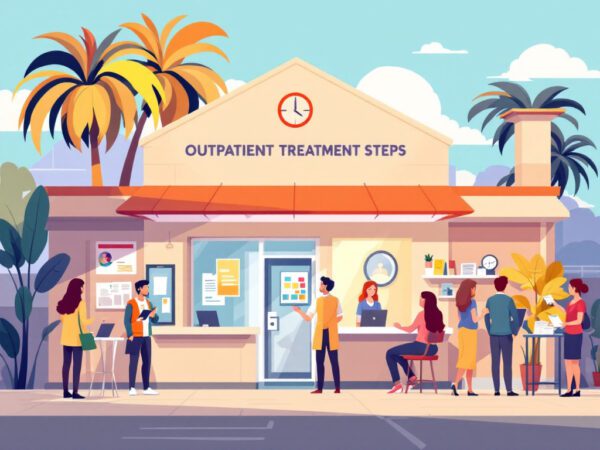Understanding Panic Disorder
Definition and Symptoms
Panic disorder is a mental health condition characterized by recurrent and unexpected panic attacks, which are sudden periods of intense fear or discomfort. During these episodes, individuals may experience various physical symptoms, such as trembling, tingling, or a rapid heart rate. These symptoms can be so severe that they may resemble a heart attack, leading to heightened anxiety and fear of future attacks. To qualify for a diagnosis, the presence of ongoing worry or behavioral changes due to the fear of future panic attacks must significantly interfere with daily life (NIMH).
Here is a summary of common symptoms:
| Symptom | Description |
|---|---|
| Palpitations | Noticeably rapid heartbeat |
| Shortness of Breath | Feeling like one cannot catch their breath |
| Trembling | Shaking or trembling sensations |
| Nausea | Upset stomach or gastrointestinal discomfort |
| Dizziness | Feeling lightheaded or faint |
Understanding these symptoms is crucial for recognizing panic disorder and seeking appropriate panic disorder therapy.
Prevalence and Onset
Panic disorder frequently begins in late adolescence or early adulthood. Research indicates that women are more likely than men to develop this condition. Though the prevalence varies, it is essential to recognize that with the right support and treatment, individuals can manage their symptoms effectively and enhance their quality of life (NIMH).
The onset of panic disorder can be sudden, and while some individuals experience multiple panic attacks each day, others may encounter them only a few times a year. Understanding these patterns can aid in developing strategies for coping and recovery. For comprehensive treatment options, consider looking into various therapies such as cognitive behavioral therapy or dialectical behavior therapy, which can be beneficial in addressing panic disorder effectively.
Treatment Options for Panic Disorder
When addressing panic disorder, it’s crucial for us to explore the various treatment options available. These treatments can significantly improve the quality of life for individuals suffering from panic attacks. The primary approaches include psychotherapy, medication, and a combination of both.
Psychotherapy Approaches
Psychotherapy is regarded as an effective first-line treatment for panic disorder. Among various types of therapy, cognitive behavioral therapy (CBT) is particularly prominent. It focuses on helping patients understand and cope with their symptoms. This form of therapy equips individuals with coping strategies to confront their fears and gradually overcome situations they’ve avoided due to their panic attacks.
Key elements of psychotherapy often include:
- Cognitive restructuring to challenge negative thought patterns.
- Breathing retraining to manage panic symptoms.
- Relaxation techniques to alleviate anxiety.
| Psychotherapy Type | Description | Benefits |
|---|---|---|
| Cognitive Behavioral Therapy | Focuses on understanding and coping with symptoms | Helps overcome fears and avoids situations |
| Dialectical Behavior Therapy | Combines cognitive and behavioral techniques | Effective in managing emotions |
| Mindfulness-Based Therapy | Incorporates mindfulness practices | Enhances awareness and reduces stress |
For more specialized therapies, options like art therapy outpatient or yoga therapy outpatient can also be beneficial in addressing underlying issues contributing to panic disorder.
Medication for Panic Disorder
In addition to therapy, medication plays a significant role in treating panic disorder. The main classes of medications used include antidepressants and anti-anxiety medications. These can help reduce the frequency and severity of panic attacks.
Common medications include:
- Selective Serotonin Reuptake Inhibitors (SSRIs): Often prescribed as a first-line treatment to relieve symptoms.
- Benzodiazepines: Used for short-term relief of acute anxiety symptoms.
- Tricyclic Antidepressants: Occasionally used for patients who do not respond to other treatments.
| Medication Type | Purpose | Potential Side Effects |
|---|---|---|
| SSRIs | To reduce frequency of panic attacks | Nausea, insomnia, sexual dysfunction |
| Benzodiazepines | To quickly alleviate acute anxiety | Drowsiness, dependency risks |
| Tricyclic Antidepressants | To help when other meds don’t work | Weight gain, dry mouth |
Considering the individual’s unique history and symptoms, medication can be tailored to suit personal needs, enhancing overall treatment effectiveness.
Combination Therapy Benefits
Using a combination of psychotherapy and medication often yields the best outcomes. This integrated approach addresses both the psychological and biological aspects of panic disorder. While medication can help stabilize symptoms and provide relief from distress, psychotherapy, particularly CBT, teaches long-term coping strategies and addresses root causes.
Research has shown the benefits of combining treatments, leading to:
- Quicker symptom relief.
- A comprehensive understanding of panic disorder.
- Improved long-term management strategies.
Individuals seeking treatment may also explore specialized options like group therapy addiction for social support or individual therapy focused on personal experiences and challenges.
Embracing a holistic view of treatment can empower individuals to navigate their journey more effectively. Exploring these options allows us to provide a supportive environment for those affected by panic disorder to thrive.
Effectiveness of Cognitive-Behavioral Therapy (CBT)
Cognitive-behavioral therapy (CBT) has emerged as a leading treatment for panic disorder, offering individuals effective tools to manage their symptoms and improve their quality of life. This section examines the role of CBT in treating panic disorder, the integration of exposure therapy, and the cognitive techniques utilized within this therapeutic approach.
Role of CBT in Panic Disorder
CBT is primarily focused on changing negative thought patterns and behaviors associated with panic disorder. Research has demonstrated that CBT, whether combined with exposure techniques or used alone, surpasses no treatment or placebo in effectiveness. This approach uses structured sessions to guide individuals through understanding their symptoms, modifying their beliefs about those symptoms, and developing coping strategies. Patients learn that the physical sensations they experience during panic attacks are not harmful, which can dramatically decrease their anxiety levels.
| Efficacy Comparison |
|---|
| CBT + Exposure Therapy: Higher success rates |
| CBT Alone: Effective, especially for patients with comorbid symptoms |
| No Treatment/Placebo: Significantly lower effectiveness |
Integration of Exposure Therapy
Exposure therapy is a crucial component of CBT aimed at treating panic disorder. It employs various methods to confront and reduce fears associated with panic attacks. This may include imaginal exposure, in vivo exposure, or interoceptive exposure.
- Imaginal Exposure: Patients visualize feared situations to gradually lessen their anxiety.
- In Vivo Exposure: Patients confront real-life situations that cause fear.
- Interoceptive Exposure: This technique deliberately induces physical sensations associated with panic attacks to help patients learn that these sensations are not dangerous.
Interoceptive exposure, in particular, has been shown to be effective in addressing the fear of physical symptoms that can trigger panic attacks. This method is essential in shifting patients’ beliefs about their bodily sensations, ultimately helping to disconfirm catastrophic thoughts and reducing overall anxiety.
Cognitive Techniques in CBT
Cognitive techniques are integral to the effectiveness of CBT. These strategies help patients reappraise the meanings they assign to their physical sensations and stressors:
- Cognitive Restructuring: This involves identifying and challenging distorted beliefs about panic attacks and their consequences.
- Relaxation Techniques: Patients learn to implement breathing exercises and mindfulness strategies to manage acute anxiety responses.
Studies indicate that incorporating cognitive techniques is particularly beneficial for those with comorbid depressive symptoms, enhancing overall treatment efficacy. As CBT continues to be recognized as the most empirically supported psychosocial treatment for panic disorder, incorporating these cognitive and exposure strategies can foster significant improvements in managing panic disorder symptoms.
For further information on therapies related to anxiety and panic disorder, explore our resources on cognitive behavioral therapy, dialectical behavior therapy, and mindfulness-based therapy.
Self-Care and Lifestyle Strategies
Taking charge of one’s mental health alongside professional treatment can significantly enhance recovery from panic disorder. By incorporating self-care and lifestyle adjustments, we can create a supportive environment that fosters healing and resilience.
Complementing Professional Treatment
Integrating self-care practices with professional treatment, such as cognitive behavioral therapy or medication, can lead to better outcomes. Regularly engaging in self-care routines can help alleviate some symptoms, making therapy sessions more effective.
| Self-Care Practice | Benefits |
|---|---|
| Physical Exercise | Reduces anxiety and improves mood |
| Mindfulness Meditation | Enhances awareness and reduces stress |
| Journaling | Provides an outlet for emotions and tracking triggers |
In addition to these practices, participation in therapy like mindfulness-based therapy can reinforce the coping strategies learned during treatment.
Importance of Self-Care
Self-care is not just a buzzword; it plays a critical role in maintaining mental health. Establishing a routine that prioritizes mental well-being can create a buffer against anxiety and panic attacks. We should be mindful about:
- Getting adequate sleep
- Eating a balanced diet
- Setting boundaries in personal and professional life
- Engaging in hobbies and activities that bring joy
Regular self-care can improve overall emotional health, making the journey through panic disorder more manageable.
Dietary Supplements and Herbal Remedies
While some may seek out herbal remedies and dietary supplements to help manage anxiety and panic symptoms, it’s vital to approach these options with caution. According to the [Mayo Clinic](https://www.mayoclinic.org/ diseases-conditions/panic-attacks/diagnosis-treatment/drc-20376027), herbal products and supplements are not regulated by the FDA, meaning their safety and efficacy are not guaranteed. Potential interactions with prescribed medications also pose risks. Therefore, before trying any new remedy, consulting with healthcare providers is essential.
Here are some commonly discussed supplements:
| Supplement | Potential Uses |
|---|---|
| Omega-3 Fatty Acids | May reduce anxiety levels |
| Magnesium | Can promote relaxation |
| Lavender | Often used for calming effects |
In conclusion, while self-care, dietary supplements, and lifestyle strategies can enhance panic disorder therapy, they should not replace professional treatment. Seeking a balanced approach that includes both self-care and professional help can lead to more favorable outcomes.
Alternative Medicine Approaches
In addition to traditional treatments, we can explore various alternative medicine approaches that may complement panic disorder therapy. These methods include acupuncture, massage therapy, and meditation, which some individuals find beneficial in managing anxiety symptoms.
Acupuncture for Anxiety
Acupuncture has been a topic of interest for individuals dealing with anxiety. Though studies on its effectiveness for anxiety have had poor methodological quality or yielded inconclusive results, some practitioners believe that acupuncture may help relieve tension and promote relaxation. However, it remains challenging to draw firm conclusions about its potential benefits for panic disorder therapy (NCCIH).
| Study Aspect | Findings |
|---|---|
| Study Quality | Poor methodological quality reported |
| Statistical Significance | Results often not statistically significant |
For those considering acupuncture, it’s advisable to consult with a healthcare professional to discuss its appropriateness as part of their overall treatment plan.
Massage Therapy Benefits
Massage therapy has also been examined for its effects on anxiety, particularly in individuals with comorbid medical conditions such as cancer. While some studies suggest it may help reduce anxiety levels, the findings have been mixed and not consistently statistically significant (NCCIH).
| Study Aspect | Findings |
|---|---|
| Effectiveness | May help reduce anxiety in specific populations |
| Variability | Conflicting results with some studies not statistically significant |
Those interested in this therapy should seek qualified massage therapists and discuss any potential benefits or considerations with their healthcare provider.
Meditation’s Impact on Anxiety
Meditation, particularly Transcendental Meditation, has shown promise in offering small to modest benefits for individuals experiencing anxiety-related symptoms. Yet, the lack of studies with adequate statistical power regarding clinically diagnosed anxiety disorders limits the strength of these conclusions (NCCIH).
| Meditation Type | Findings |
|---|---|
| Transcendental Meditation | Small to modest benefits observed |
| Study Quality | Insufficient statistical power in existing research |
Meditation can be a useful additional strategy alongside other therapies. We encourage an open dialogue with healthcare professionals to find a suitable meditation practice tailored to individual needs.
Exploring these alternative approaches can enhance our understanding of managing panic disorder symptoms, but they should be integrated thoughtfully alongside more conventional therapeutic options like cognitive behavioral therapy and dialectical behavior therapy.
Capnometry-assisted Respiratory Training (CART)
Novel Approach for Panic Disorder
Capnometry-assisted Respiratory Training (CART) is a relatively new method that has emerged as a promising therapeutic intervention for those experiencing panic disorder. This innovative approach focuses on the use of capnometry, which measures the concentration of carbon dioxide in exhaled air, to help individuals regulate their breathing patterns during panic attacks. By providing real-time feedback, CART allows users to become more aware of their breathing and learn to control it, thereby reducing feelings of anxiety and panic.
Results and Benefits
The results from studies and clinical experiences indicate that CART can significantly alleviate symptoms of panic disorder. Users often report enhanced feelings of calmness, reduced frequency of panic attacks, and improved overall emotional regulation. The benefits include:
- Improved awareness of breathing patterns
- Reduction in anxiety and panic symptoms
- Integration into established treatment plans
- Potential for application in various therapeutic settings
| Benefit | Description |
|---|---|
| Awareness | Enhances understanding of personal breathing habits |
| Anxiety Reduction | Lowers feelings of anxiousness and panic attacks |
| Integration | Fits well with existing treatment methodologies |
| Versatility | Can be used in multiple therapeutic environments |
Comparison to Traditional Therapies
When compared to traditional therapies for panic disorder, such as Cognitive Behavioral Therapy (CBT) and exposure therapy, CART presents a unique set of advantages. While CBT focuses on altering thought patterns and managing anxiety through cognitive restructuring, CART emphasizes physiological control through breathing techniques.
CART can be particularly beneficial for individuals who may not fully respond to traditional psychotherapy methods. It serves as a complementary strategy that can be integrated with existing treatment approaches like cognitive behavioral therapy and exposure therapy. The combination of physiological and psychological support offers a more holistic approach to managing panic disorder symptoms.
The ongoing research into CART’s efficacy ensures that we can tailor treatments even more specifically to individual needs. As we continue to explore various therapy options, including mindfulness-based therapy and psychotherapy outpatient, CART stands out as a beneficial addition to the array of available interventions for panic disorder.















